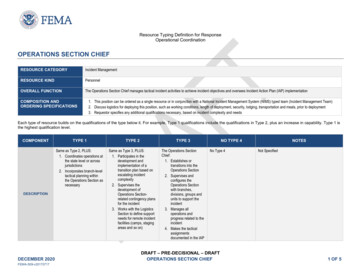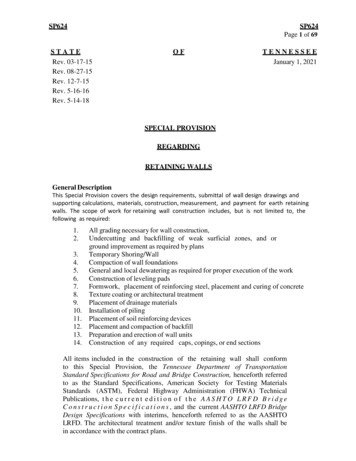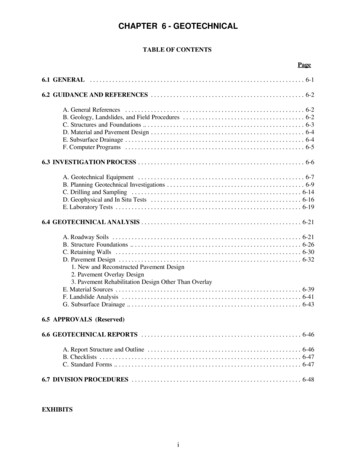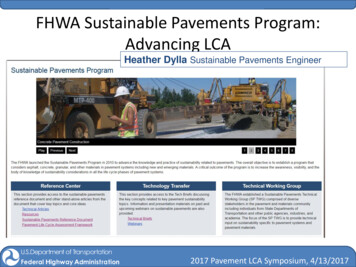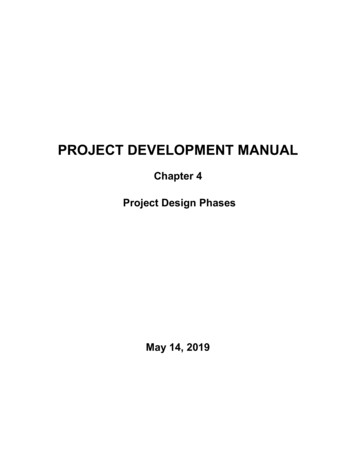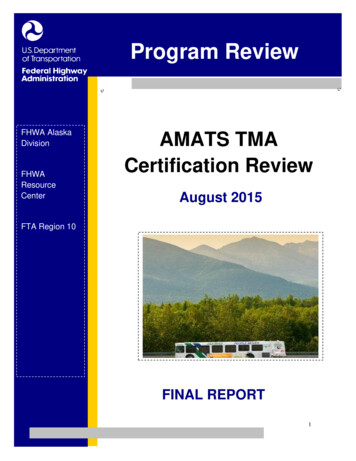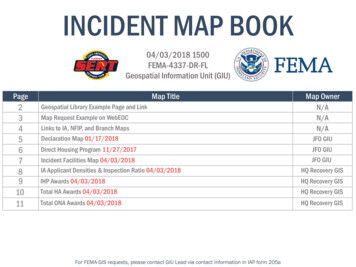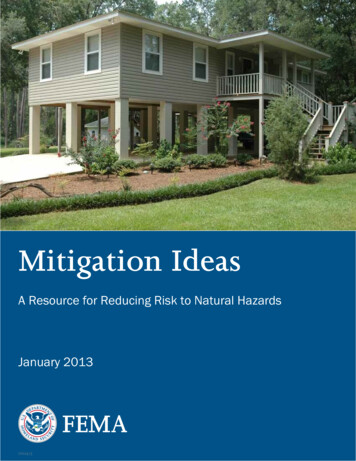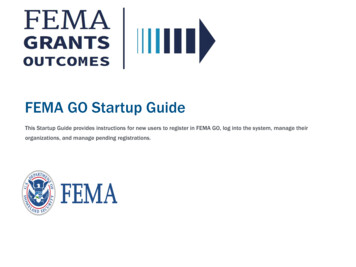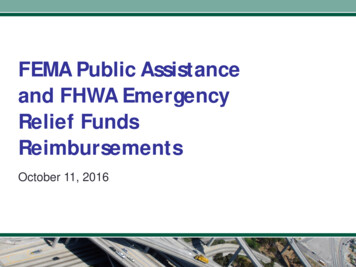
Transcription
FEMA Public Assistanceand FHWA EmergencyRelief FundsReimbursementsOctober 11, 2016
Today’s Presenters ModeratorBonnie Castillo, Iowa Department of Transportation NCHRP Synthesis 472Dr. Yuko Nakanishi & Pierre Auza, Nakanishi Research & ConsultingRene Garcia, Caltrans Vermont Agency of Transportation’s PerspectiveRichard Tetreault & Alec Portalupi, Vermont Agency ofTransportation TDOT Damage Assessment for the FHWA ER Program andFEMA PA ProgramDerial Bivens, Tennessee Department of Transportation
NCHRP is.A state-driven national program The state DOTs, through AASHTO’s StandingCommittee on Research.– Are core sponsors of NCHRP– Suggest research topics and select final projects– Help select investigators and guide their workthrough oversight panels
NCHRP delivers.Practical, ready-to-use results Applied research aimed at stateDOT practitioners Often become AASHTOstandards, specifications,guides, manuals Can be directly applied acrossthe spectrum of highwayconcerns: planning, design,construction, operation,maintenance, safety
A range of approaches and products Traditional NCHRP reports Syntheses of highway practice IDEA Program Domestic Scan Program Quick-Response Research forAASHTO Other products to fosterimplementation:– Research Results Digests– Legal Research Digests– Web-Only Documents and CD-ROMs
NCHRP Webinar Series Part of TRB’s larger webinarprogram Opportunity to interact withinvestigators and applyresearch findings.
Today’s First Presenter NCHRP Synthesis 472Dr. Yuko Nakanishi & Pierre Auza, NakanishiResearch & ConsultingRene Garcia, Caltrans
NCHRP Synthesis 472Presentation Agenda Introduction FEMA PA Program FHWA ER Program Findings1
Motivation forSynthesis2
Synthesis StructureChapter 1Chapter 2Chapter 3 Background Program Elements DOT Experience Challenges, Findings3
Synthesis Structure Case Examples - California, Florida, Iowa, Louisiana,Missouri, New York, Tennessee, Texas, Wisconsin,Chapter 4Vermont Conclusions, Research NeedsChapter 5 Web-onlyAppendices4
Background“The intention of bothprograms is tosupplementstate and local resourcesto address the significantexpenses caused bynatural disasters andother extraordinaryconditions.”Exec. Summary,NCHRP Synthesis 472Legislative AuthorityFEMA PA Program Robert T. Stafford Disaster Reliefand Emergency Assistance ActFHWA ER Program Section 125 of US Code Title 23MAP-21 and FAST Act5
FHWA ER ncyRepairRoads & bridges on federal-aid highwaysNatural disaster, catastrophic failure due toexternal causePresidential declaration or governor’sproclamation 700,000 statewide for federal share100% federal sharePermanent 90% for Interstate,Restoration 80% for Other – federal share6
FEMA PA Program* Distinction made between Large and Small projectsNon federal-aid facilitiesFacilitywith the exception of debrisMajor disaster or emergencyCauseRequiredPresidential declarationMinimumThresholdEmergencyRepairBased on statewide per capita indicators.75% federal share (minimum)Permanent 75% federal share (minimum)Restoration7
8
PA Program Implementation Process, page ix,FEMA Public Assistance Program and Policy Guide (PAPPG), 20169
Post-publication Changesto FEMA PA Program:The Public Assistance Program and Policy Guide(PAPPG) Combines FEMA PA policy into a single volume Provides clear overview of PA process Facilitates consistent/efficienteligibility determinations Includes updates based on Title 2, CFR Part 20010
FHWA ER ndard orQuick Release Governor’sProclamation orPresident’sDeclaration Letter of Intent,Acknowledgement Inspections Detailed DamageInspection Report(DDIR) DOT request Damage SurveySummary Report(DSSR) FHWA DSSRReview, Approval Allocation offunds Program ofProjects11
Post-publication Changesto FHWA ER Program: FAST ACT (2016-2020)– Continues the FHWA ER Program– Funding authorizations remain @ 100 M per year New FHWA Order (Feb. 22, 2016)– Strengthens administration and oversight– Ensures the effective use of funds– Delineates responsibilities
List of TablesTopicProgram ElementsComparison of Traditional &Quick Release MethodsTable, PageTable 3, page 21Table 4, page 23Pay attention to staff placement and replacement.Put programs in place to ensure that staff has training andexperience to be able to think on their feet. Conduct interagencytraining and exercises with other state agencies, such asemergency management and state patrol.Eligibility CriteriaMinimum Site ThresholdsTable 5, page 26Table 6, page 29Work Completion DeadlinesTable 8, page 31Important Process DeadlinesTable 7, page 30Table 9, page 32Table 10, page 34Small vs. Large Projects (FEMA)Disaster Assessment Methods13
FindingsAlign systems, processes, and technologieswith program requirements.Good business & management practicescontribute to successful reimbursements.Establish effective working relationships withfederal, state, local partners.Pre-assign key roles.Learn from previous disasters;resolve issues before the next one.14
FindingsUnderstand NIMS & ICSrecord-keeping procedures & forms.Deliver training on reimbursement programs &proceduresto all affected personnel.Meet emergency work deadlines bystreamlining necessary activities(e.g., site inspection, contracting, environmental).State-to-state variations in various areas exist(e.g., environmental laws, equipment rates,documentation policy).15
Useful Policy/PracticeAfter Action ReportsDevelop AARs after disasters or large incidents/eventsaddressing improvements to reimbursement processes(all case study agencies)Predesignated Reimbursement CoordinatorsAssign specific agency staff the role of reimbursementcoordinator prior to a disaster or emergency(all case study agencies)Identified through case studies16
Accounting/Financial ManagementUnique Project Codes for DisastersAssign unique project code for a disaster; using the code forall disaster-related expenses helps to monitor magnitude ofexpenses and submit them for reimbursement purposes(all case study agencies)FHWA FMIS AccessFiscal Management Information System(most case study agencies)Source: pixabay.comIdentified through case studies17
Documentation/InformationManagementCentral Location / Drive(all case study agencies)Electronic Storage(all case study agencies)“Effective informationmanagement practices,including storage of informationin a central location can save staff time.Electronic SignatureSystematic Record-Keeping,Use of ICS FormsOptical Character RecognitionSoftwareIdentified through case studiesElectronic formats canfacilitate electronic transmittalof documentation,conserve storage space, andaccommodate duplicaterequests for documentation.”18p.54, NCHRP Synthesis 472
Project Worksheet, DDIR, DAFElectronic Worksheet/DDIR/DAFUse electronic forms to facilitate document storage and updates/additions to the forms.Automated Distribution SystemUse of combined DDIR/PW formIdentified through case studies19
Site AssessmentBridge/Highway/Pavement ManagementSystem(all case study agencies)Preestablished Repair or Route PrioritizationMethod(some case study agencies)Geospatial Data/Lidar (some case studyagencies)Predesignated Assessment TeamsWeather Information Service/SystemAutomated Damage-Recording Vanto establish pre-disaster conditionsAerial Imagery ServicesAbility for Teams to be Self-Sustaining“In order to facilitate siteassessments, information packets aredistributed to assessment teams.Also, a weather informationsystem and bridge, highway, andpavement management systemsas well as a bridge monitoring systemare employed to facilitate theassessment process. Historical dataare mapped to show repetitivelosses – this has been useful injustifying betterments and theinclusion of mitigation measures.Geospatial data using LiDAR arealso useful in identifying damagesand the cause of damagedinfrastructure.”Iowa DOT Case Study, App. D, NCHRP Synthesis 472Web-based Map (some case study agencies)Identified through case studies20
FHWA Emergency Relief Reimbursement process trainingTraining(all case study agencies)FEMA Public Assistance Reimbursement process training(all case study agencies)Disaster Assessment training (all case study agencies)Training for Local Public Agencies (all case study agencies)Use of Scenarios from Prior DisastersTraining for State EMAsIdentified through case studies21
ContractingEmergency Waivers(e.g., Permits)Contractor DatabaseStandardized Payments to ContractorsOne POC for Plans/BlueprintsSource: pixabay.comIdentified through case studies22
AppealsDiscussion with FHWADivision OfficeCitation of Relevant LawsCitation of Prior Decisions(Precedents)“When FEMA or FHWA deniesapplications or specificexpenses, formal appealsrequire the state DOT toprovide justification, additionalinformation, and reasons thedecision should be reversed.The state DOT may also need toreview policy or regulations andcite specific sources oflegislation.”p.43, NCHRP Synthesis 472Identified through case studies23
Concluding Thoughts Keep current with FHWA and FEMA guidance Communicate regularly with FHWA andFEMA, LPAs, and State EMA Train all relevant personnel(don’t forget accounting, financial personnel) Leverage new technologies24
NCHRPSynthesis 472FEMA and FHWA EmergencyRelief Funds Reimbursementsto State Departments ofTransportationVermont Agency ofTransportation’sPerspectiveRichard M. TetreaultDeputy Secretary ofTransportation
Vermont Agency of Transportation Lessons Learned Disaster Preparedness Documentation Program Management2
Lessons Learned Irene Innovation Task Forceo Lessons learned from Tropical Storm Irene response and recoveryo To gather, organize, and compile innovative practices/ideas Emergency Worko FHWA ER vs FEMA PAo Timeframes differo Subtle differences in work types Construction Contractingo VAOT use of Maintenance Rental Agreements (FHWA vs FEMA)o VAOT as a “contractor” for municipalities under FEMA PAo VAOT contractors doing work on municipal roads under FEMA PA3
Disaster Preparedness Development and maintenance of manualso Incident Command Post (ICP) Administrative Manualo FHWA Emergency Relief Manual (VAOT) Damage Assessment Application (for handheld devices)o Used by VAOT field staff for both FEMA PA and FHWA ER-eligible siteso Allows for quick summary of total damages and determination of meeting disasterthresholds Retainer Contractso Construction and materials contracts in place before disaster strikeso Consult with FHWA and FEMA on such contracts before implementing TrainingooooIncident Command SystemRivers and Roads TrainingDamage AssessmentDocumentation/Programming4
Documentation Detailed Damage Inspection Report (DDIR)o Customized by VAOT to include additional information from FEMA PAProgram Project Worksheets (show new DDIR)o Created at HQs based on damage assessment data collected by District staff FEMA Forms: Summary, Contracts, Materials, Equipment,Force Account used for both FEMA PA and FHWA ERreimbursements5
Programming Creation of Expenditure Accountso As soon as DDIRs are complete, expenditure accounts createdo Same applies for FEMA PA-eligible costs (primarily debris and State-ownedrail damages) Programming Requests to FHWAo Submit as soon as FWHA approves declaration Briefingso FEMA Public Assistance Applicants Briefingo FHWA Emergency Relief Applicants Briefing6
TDOT Damage Assessmentfor theFHWA ER Program and the FEMAPA ProgramFEMA Public Assistance and FHWA Emergency ReliefPrograms Webinar11 October, 2016Derial W. Bivens, CEMPTennessee Department of Transportation
FEDERAL DISASTER PROGRAMSER Program- most cases Lower threshold to declareevent Higher reimbursementratesFEMA- debris cleanup Primarily vegetative/woodymaterials
TIMELINETimeMilestoneBeginDisaster event occursDay 1Preliminary assessment beginsDay 2Detailed assessment beginsDay 14Letter of Intent6 WeeksDamage Survey Summary Report3 MonthsProgram of Projects180 DaysEmergency repairs complete2 YearsList of all sites and repair costs
INITIAL STEPS1) Preliminary DamageAssessment Windshield/aerial surveys Photos of damage2) Presidential Declaration orGovernor’s Proclamation3) TDOT - Letter of Intent4) FHWA - AcknowledgementLetter
DAMAGE ASSESSMENT1.Identify Damage Sites2.Complete Damage Assessment Forms3.Submit Damage Survey Summary Report to FHWA
DAMAGE ASSESSMENT TEAMS 5-6 HIGHLY TRAINED teams per Region Regional ER Coordinator Team core: 1 construction (practices) 1 maintenance (practices & MMS)member Regional ER Coordinator determinesdeployment and assignment areas Phase 2 Teams may include TechnicalSpecialists from any functional area
DAMAGE ASSESSMENT (FHWA)o Preliminary Assessment: Initial review of damage, i.e. windshieldsurveys A list of damage sites is developedo Detailed Assessment (Phase 1): Assessment Teams deployed Potentially eligible sites should have aformal assessmento Detailed Assessment (Phase 2): Follow up for large/complex sites May involve technical specialistso Revisions
DAMAGE ASSESSMENT FORM5Components: Summary Notes and Sketches Cost Calculations Maps Photos
RECOMMENDATIONS
Notes about thedamage at thesite. Slope washed out onto roadway. About 75’ long and 30’ high.Slope was about a 3:1 prior to slide (based off adjacent area. Recommend removal of remain unstable soil.Stabilize with Class B riprap.Bob Smith (TL), Tim Anderson, Jill Murphy (FHWA), Joe Harris(Chatt)Notes/ Sketches57-03051-1A2
COST QUANTIFICATION Repair items select & quantified Estimates based on Regional Average UnitCost (from construction) Quantified for: EmergencyEmergencyPermanentPermanentRepair by In-HouseRepair by ContractRestoration by In-houseRestoration by Contract
57-03051-1A4MapsExample – Local
County(ies)ER-TN12-1-1DescriptionPPRMPIN(s)Federal Project State ProjectNumberNumber(s)EstimatedProject CostEstimatedPE/ROW/CEI 60,000 0 60,000 60,000 6,000 66,000 1,000,000 0 1,000,000Ö 50,000 0 50,000Ö 40,000 0 40,00090% 36,000PermanentRestorationER ProjectNumberEmergencyRepairPROGRAM OF PROJECTS(D 90 Days)I-40 Slide RepairContract #1ER-TN12-1-3CockeState Forces Emergency RepairER-TN12-1-2CockeI-40 Slide RepairContract #2ER-TN12-1-4CockeState Forces PermanentRestorationER-TN12-1-5CockeConsultant Records CloseoutER-TN12-2-1CampbellI-75 Slide RepairContract117146.00ER-TN12-2-2CampbellState Forces117146.00ER-TN12-2-3CampbellConsultant Records Closeout15001-419004117034.00117034.01 HWA Share 60,000 66,000100% 900,000 45,00090%07100-312944Ö 9,335,000 15,000 9,350,000100% 9,350,00007100-112804Ö 1,175,000 0 1,175,000100% 1,175,000 60,000 0 60,00090% 54,000o Projects listed by county (projects may be several sites on a route lumped together)o Projects identified as emergency repair or permanent restorationo Estimated repair costs and federal share identified.Ö
o Incident Command Post (ICP) Administrative Manual o FHWA Emergency Relief Manual (VAOT) Damage Assessment Application (for handheld devices) o Used by VAOT field staff for both FEMA PA and FHWA ER-eligible sites o Allows for quick summary of total damages and determination of meeting disaster thresholds Retainer Contracts
